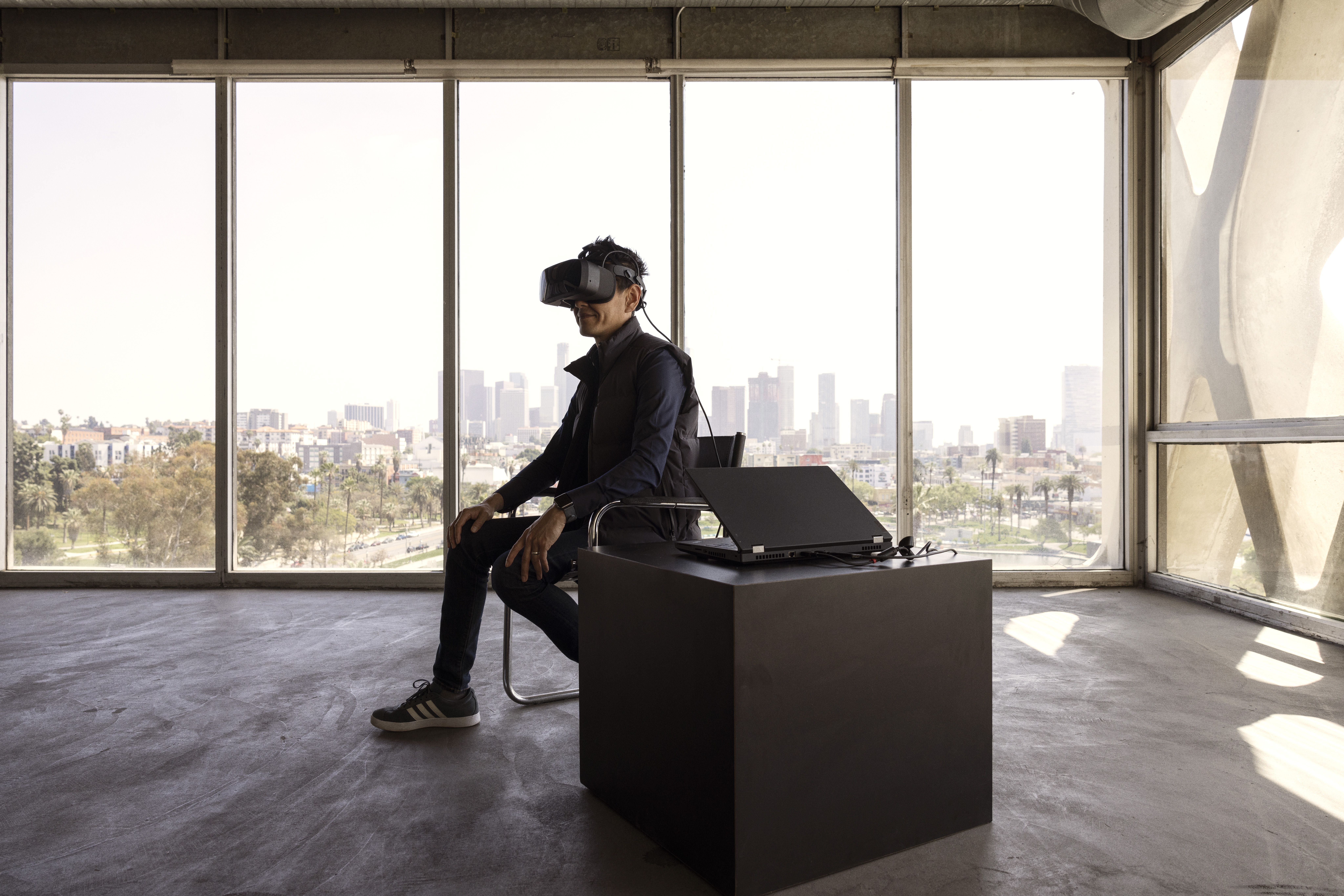
Varjo Makes Cloud-Based, High-Fidelity VR/XR Delivery a Reality Using Amazon EC2 G5 Instances
2022
Varjo, an industry-leading provider of professional-grade solutions for virtual reality (VR) and mixed reality—a type of extended reality (XR)—is transforming its business using the cloud. The company began as a manufacturer of high-end VR/XR headsets, and its vision is to extend the use and capabilities of high-quality immersion to the business world and beyond. “Our goal since the company’s formation has been to transform the way that people design, train, work, and collaborate with lifelike virtual and mixed reality,” says Urho Konttori, founder and chief technology officer of Varjo. “Now we’re taking the company in the direction of providing not only advanced devices but also full services.”
To realize its vision, Varjo used Amazon Web Services (AWS) to develop Varjo Reality Cloud, a service that businesses can use to run immersive workloads in the cloud at scale with exceptionally high visual quality. Using Varjo Reality Cloud, customers can deploy immersive applications and computer-aided design (CAD) programs, such as Autodesk VRED, from the cloud so that teams can collaborate more efficiently across locations. Varjo’s solution uses Amazon Elastic Compute Cloud (Amazon EC2)—which provides resizable compute capacity for virtually any workload—to offer a scalable, low-latency, globally available workspace for businesses to collaborate virtually, iterate photo-realistic designs faster, and reduce capital expenses.


Our solution is possible because of the leap in GPU power that we gained by using the new Amazon EC2 G5 Instances. These instances are the cornerstone of our solution’s ability to move high-fidelity workloads—that were previously only available to be run on a hefty local PC—to the cloud.”
Juho Hyytiäinen
Product Manager, Varjo
Using AWS to Deploy VR Workloads in the Cloud
Founded in 2016, Varjo has branched out from producing VR/XR headsets to developing a solution to run customers’ immersive workloads in the cloud. In 2019, the company joined the AWS SaaS Factory Program—which can be used to design, build, and launch software-as-a-service (SaaS) solutions—and collaborated with the AWS SaaS Factory team, which provided business and technical advice, to develop its solution. Using AWS accelerated Varjo’s speed to market. “We’ve spent approximately 1 year developing the product,” says Juho Hyytiäinen, product manager for Varjo Reality Cloud. “If we had built the code from the ground up rather than using services from AWS, we would have spent closer to 2–3 years.”
In 2021, AWS released Amazon EC2 G5 Instances powered by NVIDIA A10G Tensor Core GPUs, the latest generation of NVIDIA GPU-based instances that can be used for a wide range of graphics-intensive and machine learning use cases. These instances support NVIDIA RTX Virtual Workstation and NVIDIA CloudXR technologies, which power some of the most innovative visual computing and VR experiences. “Our solution is possible because of the leap in GPU power that we gained by using the new Amazon EC2 G5 Instances,” says Hyytiäinen. “These instances are the cornerstone of our solution’s ability to move high-fidelity workloads—that were previously only available to be run on a hefty local PC—to the cloud.”
Facilitating Faster Designs and Better Collaboration with a Cost-Effective, Low-Latency Solution
Varjo’s cloud-based solution, powered by Amazon EC2 G5 Instances, makes virtual collaboration simple for customers. Teams can upload and share extremely large workloads on Varjo Reality Cloud without worrying about local compute capacity or needing to provision expensive computing hardware. Using Varjo Reality Cloud, teams can design faster and produce better results. “In automotive design, creating physical models to see the current design can easily take 2 weeks. If you want to change something, you need to wait 2 more weeks,” says Konttori. “Using VR, you can see changes immediately, which brings much faster iterations that ultimately lead to better designs.” Using Varjo’s advanced pass-through XR technology, automotive designers can also see the materials for the interior design of a vehicle more accurately. One car company tested its interior design with test drivers who wore Varjo headsets that mixed a display of the road with an overlay of the proposed interior of the car. That customer was able to complete designs—which it had originally scheduled 2 years to complete—in only 1 month using Varjo’s true-to-life XR technology.
Varjo’s human-eye resolution VR/XR technology helps customers save money. Customers in aviation and aerospace training, a major market for Varjo, can use Varjo’s solutions to replace traditional simulators—which cost millions to construct and bear huge operational costs. According to one customer, the entire cost of setting up a simulation system using Varjo’s headsets and Varjo Reality Cloud is equal to the cost of 4 hours of using a typical pilot simulator. Varjo’s VR devices have also been used to remotely train the space crew for the first Boeing Starliner flight. “Training with Varjo’s headsets, astronauts can feel as if they are sitting in the same cockpit with their colleagues running the training exercises,” says Konttori. In the future, Varjo Reality Cloud can help further reduce hardware requirements and associated costs for training and simulation use cases.
Varjo Reality Cloud uses Amazon EC2 G5 Instances to power its near-real-time delivery of immersion workloads. Varjo can also pass savings to customers because Amazon EC2 G5 Instances are cost effective. “We saw huge savings when Amazon EC2 G5 Instances were introduced,” says Hyytiäinen. “These instances have a really good balance of compute capacity and price.” Amazon EC2 G5 Instances deliver low latency, which is key for Varjo not only to deliver lifelike images in near real time but also to reduce the motion sickness some people experience using VR headsets. Varjo negates latency-related motion sickness using late latching, a method of updating images at the last possible moment before they display. “The brute force of the rendering capabilities Amazon EC2 G5 Instances deliver is crucial to the low latency,” says Hyytiäinen. These instances also reduce the time it takes for customers to access the same file on different devices, such as when reading the 3D model of a car from shared design servers. “Using AWS, the data can move at blazing fast speeds between machines, removing a lot of painful waiting and buffering,” says Hyytiäinen.
Bringing Immersion and VR to New Use Cases
In the future, Varjo hopes to bring immersion to a wider market of professional use cases by removing friction from traditional workflows. “Imagine an architecture agency that wants to use immersive computing only 2 hours a week,” says Konttori. “Instead of purchasing and maintaining a separate, high-end computer, the agency can buy a headset and get as much compute power as it needs for 1–2 hours of meeting time. It pays for only the hours that actually matter.”
Varjo Reality Cloud is commercially available to customers as of April 2022. The first supported software to stream from the cloud is Autodesk VRED, and the service will be extended to other workflows during 2022. “With Varjo Reality Cloud, we are transforming the business model of our company,” says Konttori. “Using AWS gives us a globally deployable means to run our application, implementation, and rendering. Varjo is now on a trajectory where most of our future business will include computation in the cloud.”
About Varjo
Founded in 2016 in Finland, Varjo is a virtual reality headset manufacturer and service provider. The company is on a mission to transform the way that people design, work, and train using virtual, augmented, and mixed reality technology.
Benefits of AWS
- Gained 3x the frame rate using NVIDIA-powered Amazon EC2 G5 Instances
- Reduced costs using NVIDIA-powered Amazon EC2 G5 instances
- Reduced time to market from 2-3 years to only 1 year
- Saves customers million of dollars in capital expenses for training facilities
- Reduced 1 customer's design timeline from 2 years to 1 month
- Facilitates efficient remote collaboration
- Reduces custome time to market through faster iterations
AWS Services Used
Amazon EC2
Amazon Elastic Compute Cloud (Amazon EC2) is a web service that provides secure, resizable compute capacity in the cloud. It is designed to make web-scale cloud computing easier for developers.
Amazon EC2 G5 Instances
Amazon EC2 G5 instances are the latest generation of NVIDIA GPU-based instances that can be used for a wide range of graphics-intensive and machine learning use cases.
AWS SaaS Factory Program
The AWS SaaS Factory Program helps AWS Partners at any stage of the software-as-a-service (SaaS) journey. Whether you are looking to build new products, migrate existing applications, or optimize SaaS solutions on AWS, the AWS SaaS Factory Program can help.
Get Started
Companies of all sizes across all industries are transforming their businesses every day using AWS. Contact our experts and start your own AWS Cloud journey today.